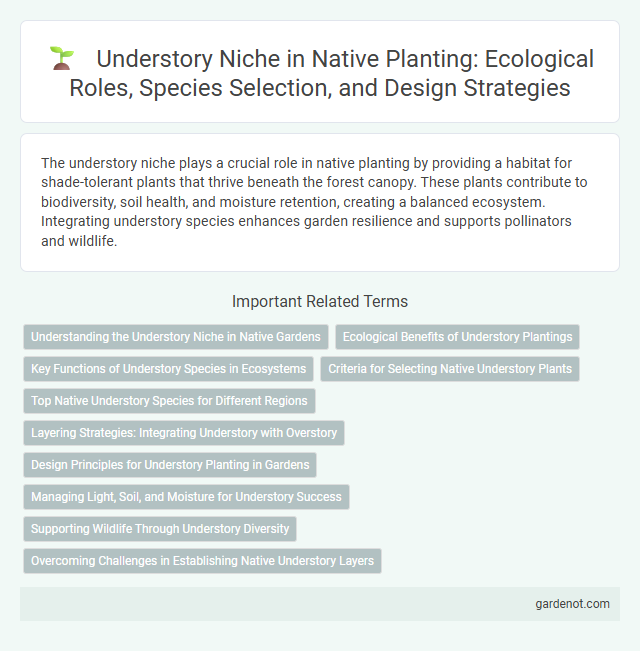The understory niche plays a crucial role in native planting by providing a habitat for shade-tolerant plants that thrive beneath the forest canopy. These plants contribute to biodiversity, soil health, and moisture retention, creating a balanced ecosystem. Integrating understory species enhances garden resilience and supports pollinators and wildlife.
Understanding the Understory Niche in Native Gardens
The understory niche in native gardens comprises shade-tolerant plants that thrive beneath the canopy, playing a crucial role in creating biodiversity and supporting local ecosystems. These species, such as ferns, shade-loving wildflowers, and small shrubs, enhance soil health and provide habitat for pollinators and wildlife. Proper understanding of light levels, moisture, and soil conditions is essential for selecting appropriate understory plants that contribute to resilient and sustainable native landscapes.
Ecological Benefits of Understory Plantings
Understory plantings enhance biodiversity by providing habitat and food sources for pollinators, birds, and beneficial insects, contributing to ecosystem resilience. These plants improve soil health through nutrient cycling and moisture retention, reducing erosion and supporting root systems of overstory trees. By creating microclimates, understory vegetation moderates temperature fluctuations and increases overall forest productivity.
Key Functions of Understory Species in Ecosystems
Understory species play a crucial role in enhancing biodiversity by providing habitat and food sources for various insects, birds, and small mammals within native ecosystems. Their functions include soil stabilization, nutrient cycling, and microclimate regulation, which support canopy tree growth and overall forest health. These plants also contribute to pest control and pollination, making them integral to ecosystem resilience and sustainability.
Criteria for Selecting Native Understory Plants
Selecting native understory plants requires evaluating shade tolerance, soil moisture preferences, and compatibility with existing canopy species to ensure ecological harmony. Plants must exhibit resilience to local pests and diseases while supporting native wildlife through food and habitat provision. Prioritizing species with deep root systems promotes soil stability and nutrient cycling, enhancing overall forest health.
Top Native Understory Species for Different Regions
Top native understory species vary by region to support local ecosystems and biodiversity effectively. In the Pacific Northwest, native ferns like Sword Fern (Polystichum munitum) and Oregon Grape (Mahonia aquifolium) thrive in shaded understory environments. The Southeast favors native shrubs such as American Beautyberry (Callicarpa americana) and Oakleaf Hydrangea (Hydrangea quercifolia), which provide essential habitat and food sources.
Layering Strategies: Integrating Understory with Overstory
Integrating understory plants with overstory trees enhances biodiversity by creating multiple habitat layers that support diverse wildlife and improve ecosystem resilience. Effective layering strategies involve selecting shade-tolerant native species for the understory that complement the overstory's canopy structure and root systems. This approach promotes nutrient cycling, soil health, and microclimate regulation, essential for sustainable native planting designs.
Design Principles for Understory Planting in Gardens
Understory planting in gardens thrives by selecting shade-tolerant native species that balance light requirements with soil moisture and nutrient availability. Effective design principles prioritize layering plants with varying heights, textures, and growth habits to create a multi-dimensional, resilient ecosystem beneath the canopy. Incorporating native understory plants enhances biodiversity, supports pollinators, and contributes to the overall health and stability of garden landscapes.
Managing Light, Soil, and Moisture for Understory Success
Managing light, soil, and moisture is crucial for understory niche success in native planting. Selecting shade-tolerant species that thrive under filtered light optimizes photosynthesis and growth, while ensuring rich, well-draining soil supports root development. Consistent moisture levels tailored to the specific understory plants prevent stress and promote biodiversity in woodland ecosystems.
Supporting Wildlife Through Understory Diversity
Understory planting enhances habitat complexity, providing critical cover and food resources for diverse wildlife, including pollinators, birds, and small mammals. Selecting native shrubs, ferns, and herbaceous plants fosters seasonal nectar, berries, and nesting sites essential for sustaining biodiversity. Maintaining a varied understory supports ecological resilience and promotes natural pest control by attracting beneficial insects.
Overcoming Challenges in Establishing Native Understory Layers
Establishing native understory layers requires attention to light availability, soil quality, and moisture retention to support diverse shade-tolerant species. Selecting native plants adapted to local microclimates enhances survival rates and resilience against invasive species. Employing techniques such as mulch layering and soil amendments improves nutrient cycling, fostering robust understory growth.
Understory niche Infographic

 gardenot.com
gardenot.com